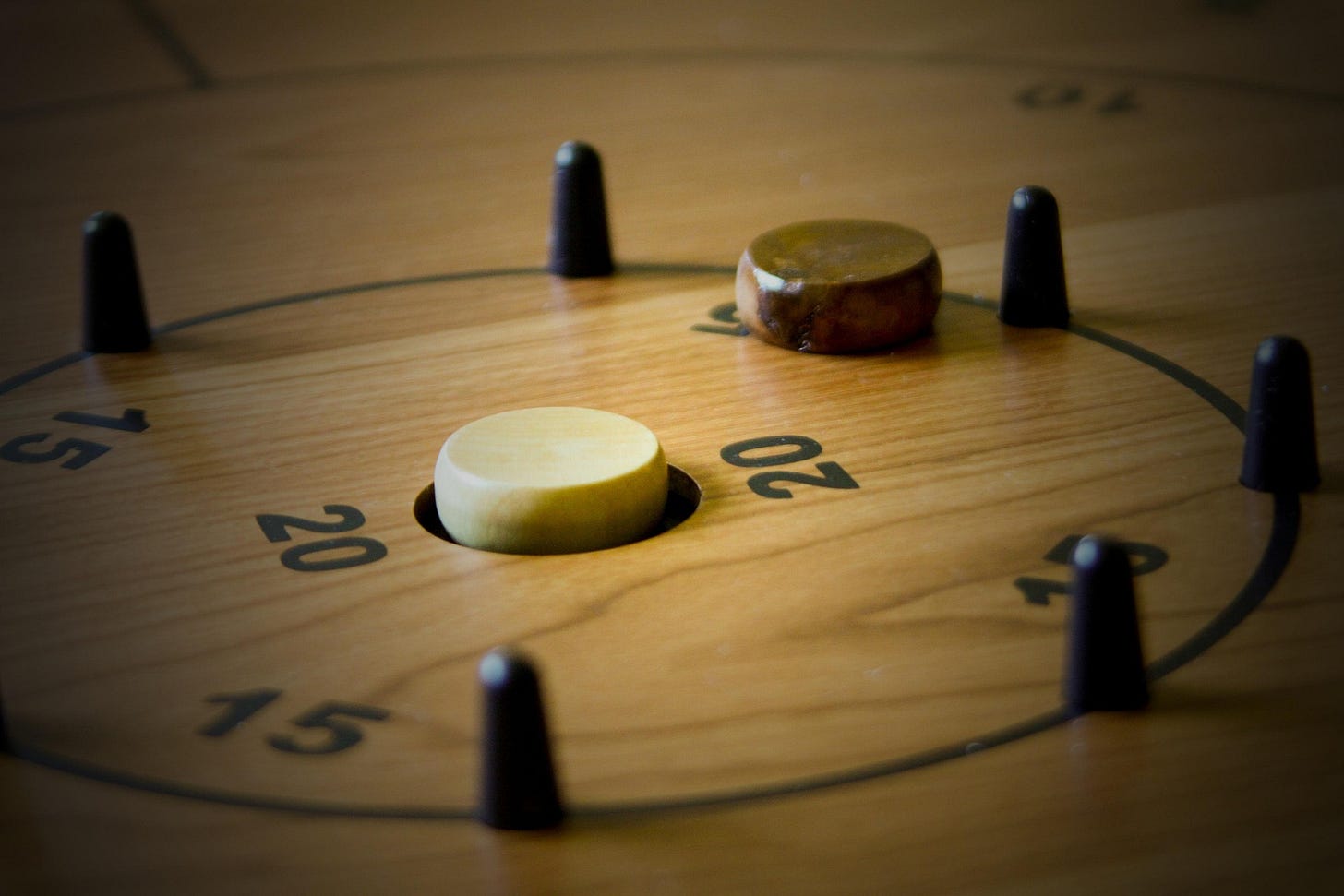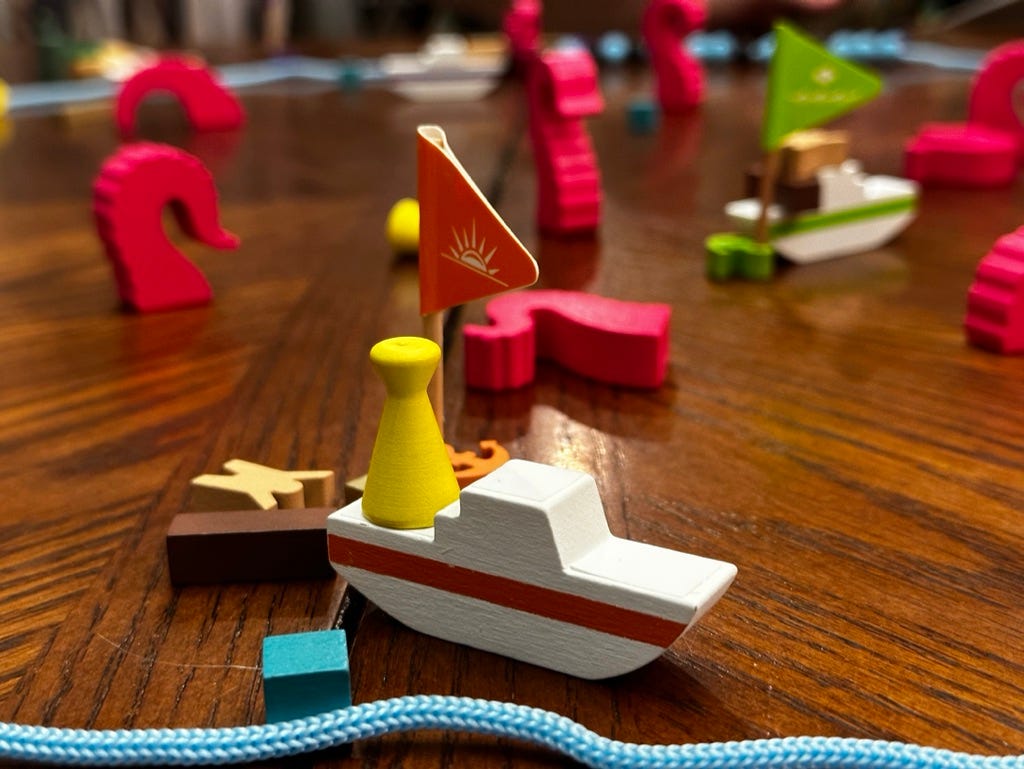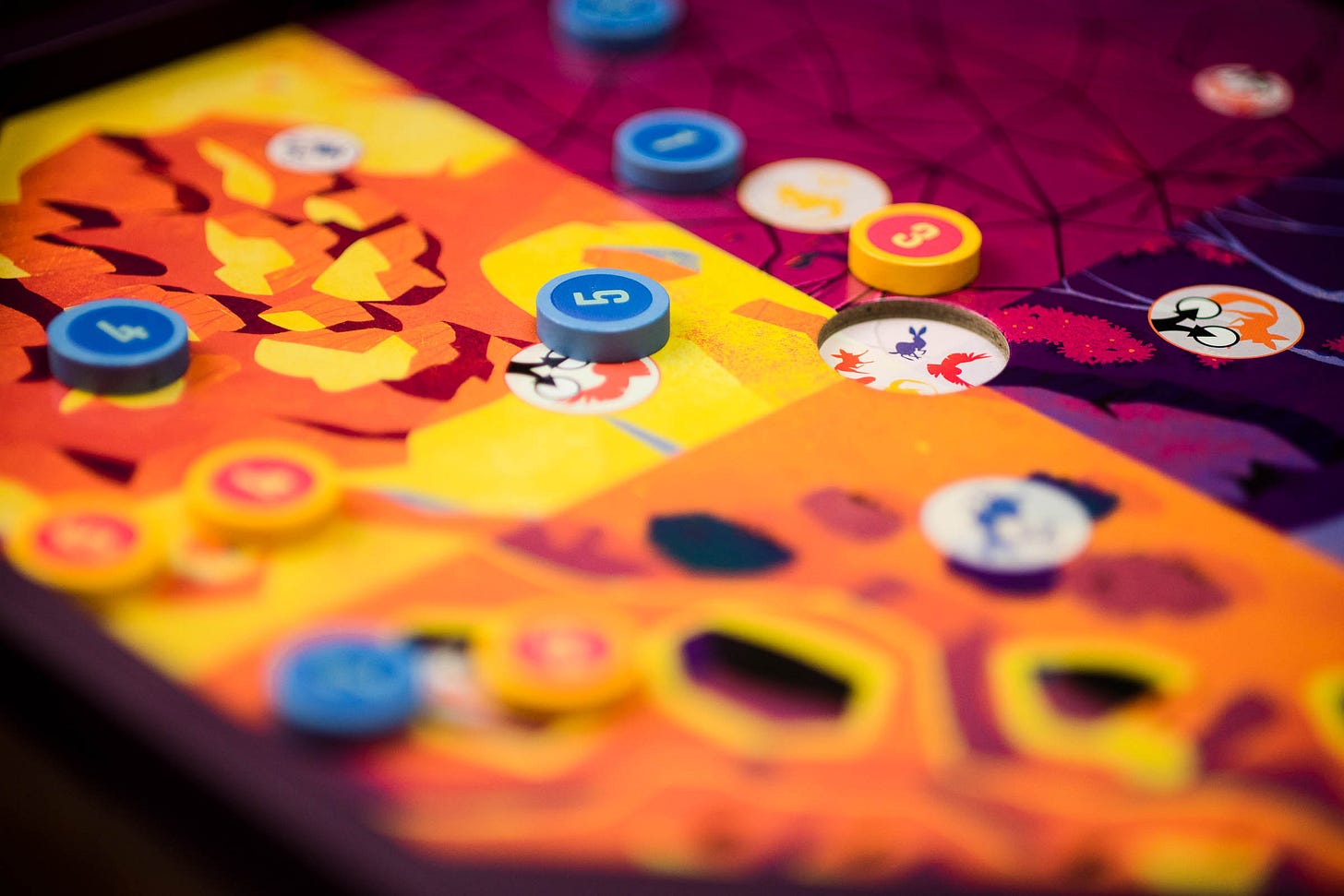Why are great flicking games hard to come by?
Flicking games underwent a small resurgence, but why aren't there more of them?
It’s Tuesday night (and Wednesday afternoon) as I write this, having just returned home yesterday evening from a long excursion to Salt Lake City, where I spent a fair amount of time with friends and family. Some of that time, of course, was spent playing games. Some of it was not, as it should be. (I’m no purist. I think you need more than just games.) Would I loved to have spent more time playing games? Of course. But needs must, and I’m happy to report that I played some interesting games — including, as you’ll see, my very first play of Crokinole.

Crokinole (uncredited, 1876) is sort of regarded as the grandfather of the modern dexterity board game. The whole game is about flicking discs into a central area on a big round board, with pegs that sort of cordon off the point-scoring area. Unlike well-established games like billiards or pool, it’s portable. You might not take a board on the train (you technically could — it’s not that big, but you should probably get a carrying case before you do), but you could definitely stash it in the back seat on the way to game night without any trouble.
Crokinole has a long history, though among traditional games, it’s still relatively recent, having made its apparent debut in the 19th century. It’s somewhat recently made a push into the attention of hobby gamers, owed perhaps in part to the beautiful wooden boards you play on. (It’s also a blast to play.) It requires skill, but it’s not as if you won’t be able to learn the game as a non-expert.
I’m reminded of one of the first modern dexterity games I played, Elk Fest (Huber, 1999), a design that has you flicking stones across the table to provide a path for a moose to traverse a river. It’s not a particular elegant game, and it’s made up of six ‘stones’, two landings, and two moose. Your goal is to get your moose across the table to the other person’s landing, and you do that by flicking stones such that you have another space on which you can move your moose — but, just like real life, your moose cannot jump to another set of stones. (Ed. note: I’ve done a little research here, and apparently a moose can jump quite high? That’s a terrifying fact. A reason to be careful, certainly. Mind you, moose bites can be pretty nasty.) It’s not a particularly elegant game, Elk Fest, and if you flick a stone too hard, you’re really putting yourself in a bad position, and it’s hard to recover from those.
But what Elk Fest lacked in elegance, it made up for in raw fun. The number of times I stayed up late with a friend playing this game, flicking my stone completely off the table by pure accident — well, let’s just say I should have learned a little more caution, and I simply didn’t. Flicking games have never been my specialty, despite my unadulterated love for them.
Crash Octopus (Shimamoto, 2021) is another flicking game that holds a special spot in my heart, and it’s not because I’m good. It’s probably more because I’m bad at it, if we’re being honest. In this itten-published outing, each player is navigating a ship around treacherous giant-octopus-filled waters, attempting to collect one of five kinds of treasure from the sea. If you collect them all, you’ll win, but it was never going to be that simple. That giant octopus? You can see its head poking out from the water, and after most times when treasure is collected, each player gets to bounce a die off that octopus’ head. You might end up moving its head, one of its tentacles, or even knocking treasure off a ship — even your own. The flicking here is done with a little flag and not your finger, but a flicking game this certainly is. Designed by Naotaka Shimamoto, illustrated by Yoshiaki Tomioka, and published by itten.
There are, of course, plenty of other flicking games that might attract your attention.
PitchCar (du Poël, 1995) is purportedly one of the best, though it’s now basically unavailable in the United States. (I may have to explore importing the game from Europe. Hmm.) You’re flicking wooden discs around a race track, and everything I’ve ever seen about the game indicates it’s just loads of fun.
Sonora (Newton, 2020) is sort of a one-of-a-kind game: It’s a ‘flick-and-write’ game, meaning it takes a lot of its mechanical inspiration from roll-and-write games, what with the bonuses, track progressions, and all that. The other half of the game? That’s flicking. You’re flicking a disc into one of four different areas, which corresponds to four areas on your dry erase board. It’s a very cool idea, but I haven’t played it since moving near the Sonoran Desert. Designed by Rob Newton, illustrated by Tom Goyon and Michael Parla, and published by Pandasaurus Games.
Flick ‘em Up (Beaujannot and Monpertuis, 2015) was, for some time, the canonical flicking game. It’s themed around the near-mythical Wild West, and you can play through a number of scenarios with varying goals, obstacles, and roles. It’s a really neat game, but the original edition had wooden pieces, and subsequent editions had plastic ones — and I wonder if that might be part of the reason it hasn’t seen sustained success a decade later. Designed by Gaëtan Beaujannot, Jean Yves Monpertuis, illustrated by Chris Quilliams, and published by Pretzel Games.
Catacombs (Amos, Kelsey and West, 2010) is in my collection, having bought it used some years ago at one of my favorite game stores in Salt Lake City, Game Night Games. Unfortunately, it’s sort of just … sat since then. I think this is the motivation I need to break it out. It’s a fantasy dungeon-crawler with flicking, and what’s not to love about that wild combination of words? Designed by Ryan Amos, Marc Kelsey and Aron West; illustrated (third edition) by Kwanchai Moriya, and published by Elzra.
There are more flicking games out there to explore, but I think you’ll find it’s a fairly limited genre. There are only 373 games with the ‘flicking’ mechanic on BoardGameGeek, and that includes expansions. My initial research shows just 100 games with enough ratings to be ranked, and that’s a low bar. The remaining 273 would be expansions and games with too few ratings to count. Given the board game boom over the last two decades, that’s a surprising figure.
In the interest of completeness, here are the remaining top games, with games previously mentioned here mentioned with just a title.
1 - Crokinole
2 - PitchCar
3 - Tumbling’ Dice (Grayson, Nash & Soued, 2004) — flick dice down a stepped board
4 - Catacombs (third edition)
5 - Flick ‘em Up
6 - ICECOOL (Gomez, 2016) — flicking penguins? And you can bank them around corners and jump them over walls? Neat!
7 - Flick of Faith (Jarząbek, Stobiecki, Truchanowicz & Włodarczyk, 2019) — flicking, area control, and mythology? Hmm!
8 - Terror in Meeple City / Rampage (Bauza & Maublanc, 2013) — monsters terrorizing a city. Classic.
9 - Catacombs (first & second editions)
10 - Ascending Empires (Cooper, 2011) — Have you ever seen a flicking game that takes more than an hour to play? Also, it’s set in space.
This all does leave me to wonder: Is there something difficult about designing a flicking game? Is the space for innovation lower, or at least less obvious? Is it more expensive to produce? Certainly, flicking games — and dexterity games in general — have a well-defined audience, and it’s not difficult to introduce new players to these games, generally speaking. Crokinole took me 30 seconds to learn, roughly. (It helps to have a good teacher, but the rules explanation is generally very simple.)
I don’t even think this is necessarily a case of the BGG audience being a different one than a mass market audience, or even a general enthusiast market. There are not untold amounts of flicking games at big box stores, and these games really don’t garner public attention.
I have my hypothesis, but I can’t truly answer the question today. To really answer it, I think I need to play PitchCar, and I think I need a Crokinole board at home.
Thanks for joining me for this late edition of Don’t Eat the Meeples. I do apologize for my lateness, but I spent 8–10 hours warring with my computer when it started correct Meeple to Maple. (OK, that’s actually just something I noticed today, and I didn’t war with my computer over it.) I hope the week’s found you well, and now that I’m home, I’m itching to get some games to the table. I’m also excited to tell you about some more dexterity games I’ve played recently — none of which I’m particularly good at.






